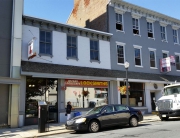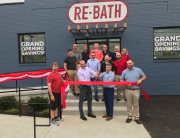Central Penn Business Journal; April 29, 2011
by Tim Stuhldreher
Midstate economic development corporations are working hard to get the word out about a new U.S. Small Business Administration program designed to help companies facing big mortgage payments in a slumping commercial real estate market.
This year and next, the SBA will allow companies to refinance real estate and equipment loans through its 504 loan program.
The key word is “refinance.” Normally, 504 loans only can be used toward new purchases. However, the federal government decided adding a temporary refinancing option would aid the recovery and help preserve jobs, said David Dickson, director of the SBA’s Philadelphia District.
Nearly 70 people attended the Capital Region Economic Development Corp.’s March 29 seminar on504 refinancing, said Linda Goldstein, CREDC’s vice president and chief operating officer.
A similar event the Economic Development Corp. of Lancaster County hosted April 12 drew more than 100, project manager Lyle Hosler said.
“There’s a high level of interest,” Goldstein said.
That’s because the program is virtually the only one of its kind. Economic development loans, as their name implies, are normally directed toward new purchases, not refinancing, Goldstein said.
During the ebullient run-up to the 2008 financial crisis, many companies took out loans to buy real estate that has since sunk in value, sometimes dramatically.
Many of those loans are coming due, and companies need to refinance to avoid large balloon payments. But in today’s weakened economy and tighter regulatory environment, banks are scrutinizing applications rigorously.
They want to see conservative loan-to-value ratios, not mortgages with outstanding balances near or exceeding a property’s current worth.
“Even small businesses that are performing well and making their payments on time can have a hard time refinancing these loans,” the SBA said in its program description.
To remedy that, last year’s Small Business Jobs Act authorized the SBA to commit $15 billion toward refinancing loans through its existing 504 program, half this year and half in 2012. The SBA began accepting loans this year.
As with normal 504 loans, banks will partner with the SBA, explained John Biemiller, vice president of the Lancaster EDC and EDC Finance Corp.
The loans use a standard formula, he said: The bank funds 50 percent, the SBA funds 40 percent and the borrower puts in the remaining 10 percent.
The bank’s loan-to-value ratio is thus 50 percent, a very safe, low ratio, he said. The SBA provides a 20-year loan (10 years for equipment) at a low fixed rate, which benefits the borrower, he said.
Commercial real estate loans typically require around 20-25 percent in borrower equity, not 10 percent, he said. With a 504 loan, a company can put down $100,000 on a $1 million loan instead of $200,000 to $250,000, and put the rest of the money to work elsewhere in the business.
“It’s a really good structure,” Biemiller said.
Lancaster EDC’s Biemiller and Hosler and CREDC’s Goldstein all said they are working closely with local banks to find good candidates for the program.
Michael DiCiaccio, assistant vice president for business and professional banking at Buffalo, N.Y.-based M&T Bank, which has 67 midstate branches, said he’s already identified several local customers who could benefit.
“It’s nice to have this in our arsenal,” he said.
The program expands bankers’ options and could potentially help companies in a wide variety of situations, he said.
Applications will probably get started by early summer, the EDC officials said. In most cases, the maximum loan is $5 million, Hosler said.
The Lancaster EDC is a certified development company, or CDC, meaning it can underwrite 504 loans directly, Hosler said.
CREDC partners with a Chester County CDC, South Eastern Economic Development Co. of Pennsylvania, or SEED Co. of Pa., to administer the loans, Goldstein said.
The SBA believes up to 20,000 businesses nationwide may be eligible to take advantage of 504 refinancing, Dickson said.
Prior to April 6, the SBA limited eligibility to companies with mortgages coming due before December 2012, he said.
That was done to ensure the neediest companies received attention first. That criterion is now waived, and any companies with eligible loans may apply, he said.
The $15 billion in lending authority is not from taxpayer dollars, Dickson noted. Rather, the agency packages its 504 loans and sells them as bonds to investors on Wall Street, he said.
Loan fees cover administrative costs, so there is no taxpayer burden whatsoever, according to the SBA website.
Time is of the essence, as the refinancing option will end in September 2012, Goldstein said.
“The program has a short window,” she said.
Key features of the 504 Loan Refinancing Program
- The 504 Loan Refinancing Program allows participants to refinance loans used to buy or upgrade real estate or long-term capital equipment.
- Borrowers can finance up to 90 percent of current appraised property value, or 100 percent of outstanding principal, whichever is lower, plus eligible refinancing costs.
- Borrowers must secure refinancing through a third-party lender (such as a bank or credit union) and an approved Certified Development Company.
- The bank’s, SBA’s and borrower’s shares of the refinancing will be 50 percent, 40 percent and 10 percent, respectively.
- Applicants must show their loans are current, and a new independent appraisal must be performed on all projects.
- Refinancing of existing 504 or government guaranteed loans is not permitted, nor is “cash out” refinancing. (The SBA may choose to lift these restrictions later.)
- The SBA began accepting applications on Feb. 28.
- The program will end on Sept. 27, 2012.
Source: Small Business Administration






Recent Comments